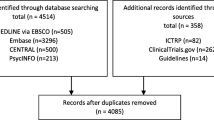Abstract
The CCR model by Charnes et al. (Eur J Oper Res 2:429–444, 1978) together with the BCC model by Banker et al. (Manag Sci 30:1078–1091, 1984) are the most popular approaches of measuring efficiency among a group of decision making units, DMUs, in data envelopment analysis, DEA. The right choice of a DEA model—CCR or BCC—often, if not always, is a difficult decision. To evaluate a DMU’s efficiency for both models might be helpful, but it does not always capture the essential issues at stake. In this paper we propose a comparative analysis of both concepts: How does activity scaling under constant BCC-efficiency influence CCR-efficiency. And inversely, how does BCC-efficiency behave when activity scaling under constant CCR-efficiency is applied. Such findings of mutual effects improve a DMU’s ability to reassess upsizing and downsizing of activities. Moreover, it allows for exact calculations of the resulting economic effects, and these effects give new insights beyond classical DEA. Finally, scale efficiency turns out to be the ideal concept to control these activity changes, rather than just CCR- or BCC-efficiency. We use a little numerical example to emphasize advantages of the new concept and sketch the new findings for a theater scenery.







Similar content being viewed by others
References
Ahn H, Le MH (2015) DEA efficiency of German savings banks - Evidence from a goal-oriented perspective. J Bus Econ 85:953–975
Banker RD, Charnes A, Cooper WW (1984) Some Models for Estimating Technical and Scale Inefficiences in Data Envelopment Analysis. Manag Sci 30:1078–1091
Banker RD, Cooper WW, Seiford LM, Thrall RM, Zhu J (2004) Returns to scale in different DEA models. Eur J Oper Res 154:345–362
Banker RD, Maindiratta A (1986) Piecewise loglinear estimation of efficient production surfaces. Manag Sci 32:126–135
Banker RD, Thrall RM (1992) Estimation of returns to scale using data envelopment analysis. Eur J Oper Res 62:74–84
Barr RS (2004) Dea software tools and technology. In: Cooper WW, Seiford LM, Zhu J (eds) Handbook on data envelopment analysis. International series in operations research & management science, 71st edn. Springer, Boston, pp 567–593
Bühnenverein D (2015) Theaterstatistik 2014/2015, Deutscher Bühnenverein Bundesverband der Theater und Orchester
Charnes A, Cooper WW, Rhodes E (1978) Measuring the efficiency of decision making units. Eur J Oper Res 2:429–444
Charnes A, Cooper WW, Lewin AY, Morey RC, Rousseau J (1985) Sensitivity and stability analysis in DEA. Ann Oper Res 2:139–156
Charnes A, Rousseau J, Semple J (1996) Sensitivity and stability analysis of efficiency classifications in data envelopment analysis. J Prod Anal 7:5–18
Cooper WW, Seiford LM, Tone K (2007) Data envelopment analysis—a comprehensive text with models. Applications, references and DEA-solver software. Springer, New York
Dantzig GB, Thapa MN (1997) Linear programming. Springer, Heidelberg
Dyckhoff H, Ahn H (2010) Verallgemeinerte DEA-modelle zur performanceanalyse. Zeitschrift für Betriebswirtschaft 80:1249–1276
Fandel G (2007) On the performance of universities in North Rhine-Westphalia, Germany: Government’s redistribution of funds judged using DEA efficiency measures. Eur J Oper Res 176:521–533
Fandel G, Gal T (2001) Redistribution of funds for teaching and research among universities: the case of North Rhine-Westphalia. Eur J Oper Res 130:111–120
Førsund FR, Hjalmarsson L (2004) Calculating scale elasticity in DEA models. J Oper Res Soc 55:1023–1038
Førsund FR, Hjalmarsson L, Krivonozhko VE, Utkin OB (2007) Calculation of scale elasticities in DEA models: direct and indirect approaches. J Prod Anal 28:45–56
Golany B, Yu G (1997) Estimating returns to scale in DEA. Eur J Oper Res 103:28–37
Hadi-Vencheh A, Foroughi AA (2006) A generalized DEA model for inputs/outputs estimation. Math Comput Model 43:447–457
Jahanshahloo GR, Hosseinzadeh F, Shoja N, Sanei M, Tohidi G (2005) Sensitivity and stability analysis in DEA. J Oper Res Soc 56(3):342–345
Jahanshahloo GR, Soleimani-damaneh M, Ghobadi S (2015) Inverse DEA under inter-temporal dependence using multiple-objective programming. Eur J Oper Res 240:447–456
Kleine A (2004) A general model framework for DEA. Omega 32:17–23
Kleine A, Dellnitz A, Rödder W (2014) Sensitivity analysis of BCC efficiency in DEA with application to European Health Services. In: Operations research proceedings 2013, Springer, pp 243–248
Kleine A, Rödder W, Dellnitz A (2016) Returns to scale revisited—towards cross-RTS. In: Ahn H, Clermont M, Souren R (eds) Nachhaltiges entscheiden. Springer, Wiesbaden, pp 385–404
Klumpp M (2017) Do forwarders improve sustainability efficiency? Evidence from a European DEA Malmquist Index calculation, sustainability, pp 1–33, https://doi.org/10.3390/su9050842
Lim D-J (2016) Inverse DEA with frontier changes for new product target setting. Eur J Oper Res 254:510–516
Podinovski VV (2017) Returns to scale in convex production technologies. Eur J Oper Res 258:970–982
Podinovski VV, Førsund FR, Krivonozhko VE (2009) A simple derivation of scale elasticity in data envelopment analysis. Eur J Oper Res 197:149–153
Rödder W, Kleine A, Dellnitz A (2017) Scaling production and improving efficiency in DEA: an interactive approach. J Ind Eng Int 1–10: https://doi.org/10.1007/s40092-017-0233-7
Wei Q, Zhang J, Zhang X (2000) An inverse DEA model for inputs/outputs estimate. Eur J Oper Res 121:151–163
Yang GL, Liu WB (2017) Estimating directional returns to scale in DEA. Inf Syst Oper Res 55:243–273
Author information
Authors and Affiliations
Corresponding author
Rights and permissions
About this article
Cite this article
Dellnitz, A., Kleine, A. & Rödder, W. CCR or BCC: what if we are in the wrong model?. J Bus Econ 88, 831–850 (2018). https://doi.org/10.1007/s11573-018-0906-8
Published:
Issue Date:
DOI: https://doi.org/10.1007/s11573-018-0906-8




